Assistive Technologies for Upper Extremity Mobility on the Farm
ID
ALCE-260NP
AgrAbility Virginia
AgrAbility Virginia promotes safety, wellness, and accessibility on the farm through education, rehabilitative services, and assistive technology. AgrAbility Virginia offers services to farmers at no cost, supports a wide diversity of farmers and farmworkers across all farming communities, and address a wide variety of disabling conditions in agriculture. Recommending assistive technologies for increased access and mobility is one way that AgrAbility Virginia supports farmers. To learn more, you can visit our website by going to www.agrabilityvirginia.org.
Assistive Technologies and Upper Extremity Mobility
Assistive technologies are used to improve accessibility and enhance independence. Recommending assistive technology is one way that AgrAbility Virginia supports farmers. Our recommendations can include a lift for a tractor or an added handrail or step to improve access, or a small modification on an existing tool such as adding a horizontal handle to a shovel for better grip strength. Assistive technologies can be highly technological like a robotic glove to help with grip strength or very ‘low tech’ like the carrying device listed below.
This infographic resource identifies examples of assistive devices for farmers who are seeking greater access and mobility on their farms. This guide focuses specifically on technologies designed for upper extremities, including those for the hand, arm, wrist, and fingers. The assistive technologies included in this guide are meant to aid people with upper extremity mobility challenges.* The assistive technologies listed here are all readily accessible, either by making it oneself (in the case of the rope guide) or by ordering online. A quick online search will lead you to an array of manufacturers for most of the items listed on the following pages. The examples below are only a starting point. The AgrAbility Virginia program is eager to discuss these and other options in depth to see if they are right for you.
Grip Modifications
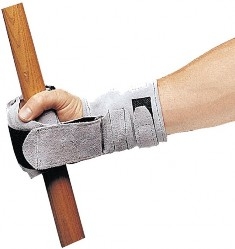
Gripping Cuff
For anyone with a condition that has reduced hand function (e.g., arthritis, carpal tunnel, stroke, spinal injury), a gripping cuff (pictured in Figure 1 (Rehab Store, n.d.)) is designed to allow them to perform tasks and utilize tools or equipment that otherwise would require a strong grip. The gripping cuff has a universal design that can be utilized in a variety of ways to promote continued engagement in farm work. Tools like hand shovels, gardening tools, one-handed tools can be easily gripped and reduce grip fatigue throughout the day.
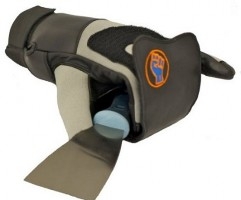
Support Gloves
Designed especially for those with hand-related impairment, support gloves (Figure 2 (ArthritisSupplies.com, n.d.)) reduce the pressure and tension in fingers, hand, wrist, and forearm. Individuals with arthritis in the hand and fingers, carpal tunnel syndrome, nerve damage, or edema can benefit from utilizing this glove option. Various models are designed for heavy-duty "trade" work, gardening, DIY projects, and sports.
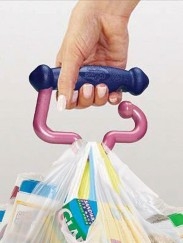
Carrying Device
This device (Figure 3 (Bloomquist, 2013)) consists of a cushioned, ergonomic handgrip and anchor-shaped design that distributes weight evenly. The design removes intense pressure on interphalangeal joints and reduces fatigue when transporting items around the farm or in the community. The carrying device can assist with weight distribution up to 50 lbs. It also has applications for use in carrying bales of hay and straw. Using it minimizes strain on the wrist and cramping of the hand. Simply twisting the device when the bags are set down prevents the items inside from falling out or spilling.
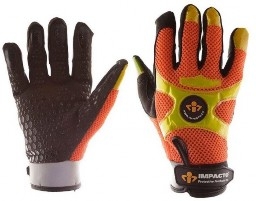
Anti-Vibration Glove
Exposure to vibrations from power tools long term can lead to increased nerve damage, joint damage and cause circulatory effects. The anti-vibration glove (Figure 4 (Impacto, n.d.)) is designed to reduce the transmission of vibration energy to the hand, arms, and shoulders. This 'bubble bladder' conforms to the flex-lines of the palm and fingers, while the multiple air cells help prevent job-specific-tool impact and vibration hazards. These gloves also increase grip strength on power tools and can reduce muscle cramps and numbness from strain.
Modified Tools
Simple modifications to common tools used within the agriculture community can address a limited range of motion in the upper extremities.

Easy Adjustable Locking Pliers
This tool (Figure 5 (Grainger, n.d.)) is designed for individuals with decreased fine motor skills in their hands and fingers. The eyebolt is a modification that allows for a larger surface area to grasp to adjust the pliers.
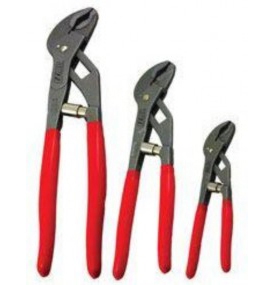
Automatic Adjusting Pliers
These pliers (Figure 6 (Mutual Screw & Supply, n.d.)) are designed for one-handed use and allow the operator to adjust the tool by squeezing the hands with different pressures. One-handed tools can support individuals who have decreased fine motor skills in one extremity, has an amputation, or has difficulty with bilateral coordination.
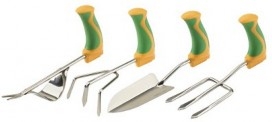
Ergonomic Hand Tools
These tools (Figure 7 (ArthritisSupplies.com, n.d.) allow individuals to complete gardening tasks using a fisted grasp in a neutral position. Positing the wrist and hand in neutral is the optimal ergonomic design. These tools are designed to decrease pain and discomfort. The support cuff, which plugs into the rear of any tool, allows the strength of the forearm and upper arm to be utilized, increasing leverage and further assisting the hand and wrist.
Driving Modifications
Many jobs and activities within the farming community require an individual to be able to drive. Driving is not limited to transportation within the community. Many farmers rely on utility vehicles like tractors, trucks, and ATVs or UTVs. Modifications can be made to the steering wheel depending on the diagnosis of the individual.
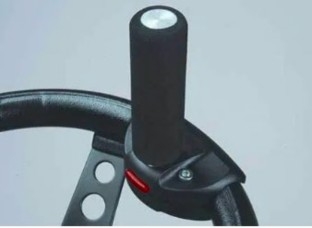
Steering Wheel Spinner:
Single-Pin (Figure 8 (MobilityWorks, n.d.)): This wheel spinner is designed for an individual with a strong wrist control but whose hand does not fully open.
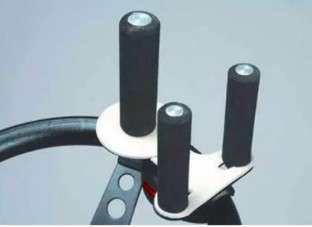
Tri-Pin (Figure 9 (MobilityWorks, n.d.)): This wheel spinner is designed for an individual with minimal grip and diminished wrist stability. The handgrips one of the adjustable pins, with the wrist secured between the other two.

Palm-Grip (Figure 10 (MobilityWorks, n.d.)): This steering wheel spinner is designed to allow one- handed steering for those with little to no grip and/or diminished wrist stability. The device's wrap-around shape cradles the hand to help prevent it from slipping off the wheel; and its liner is designed to provide both extra hand protection and comfort.
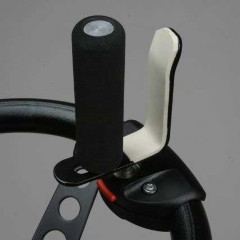
V-Grip (Figure 11 (Sportaid, n.d.)): This wheel spinner is designed for one with minimal grip plus needing extra behind-hand support; the hand grips the adjustable single pin, with a foam-wrapped post attached to the pin's base providing added support.
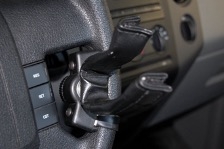
Quad Fork (Figure 12 (MPS Driving Aids, n.d.)): This wheel spinner is designed for an individual with minimal hand and wrist strength. The hand and wrist are inserted down through the top of the device, which holds them in position, with steering done primarily via arm movement.
Increasing Leverage
Increasing leverage is one simple way to reduce muscle fatigue and increasing an individual's ability to complete tasks. Leverage also prevents sustaining shoulder and back injuries that result from poor ergonomics and strained muscles.
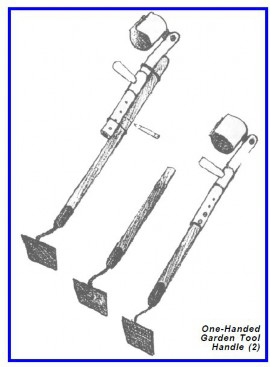
Forearm Assistive Device
Designed primarily for those with grasping limitations, upper extremity disabilities, or hand amputation, the forearm assistive device (Figure 13 (AgrAbility, 2016)) is designed to provide added support, leverage, and strength in carrying out various tasks/activities that require use of one's arm(s) while decreasing the strain in the users' shoulders, arms, and back. This device can be made at home using a two-liter plastic bottle and a hose clamp. Instructions are available in the National AgrAbility Toolbox.
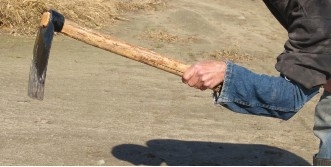
Another low-tech possibility is to simply use the cuff of old blue jeans to make a cuff to assist in holding a tool (see Figure 14 (Stoller, 2020)).
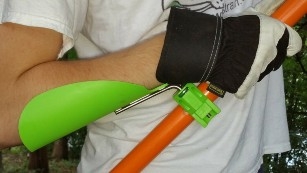
Long-Handled Tool Leverage Booster
A long-handled tool leverage booster (Figure 15 (Why Strain, n.d.)) attaches to most long-handled tools (e.g., shovel, rake, hoe, tree pruner, skimmer net, painter pole, fishing rod or net) to increase lifting leverage, thus reducing the chance of wrist, arm, shoulder, or back injury to the user. Having an adjustable bracket, this plastic with stainless steel device fits handles from 3/4 up to 1-5/8 inches in diameter, depending on the model. adjustable straps.
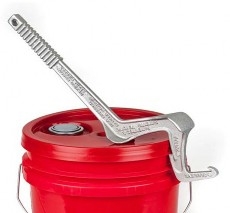
Plastic Pail Opener
This tool (Figure 16 (EBK Containers, n.d.)) allows individuals with decreased strength or finger dexterity to open necessary products by increasing their leverage.
Prosthetic Tools
An upper extremity amputation is not uncommon and can impact an individual’s ability to complete bilateral tasks. There are a variety of options and attachments for prosthetics that can allow individuals to attach tools and increase their grip to complete tasks.
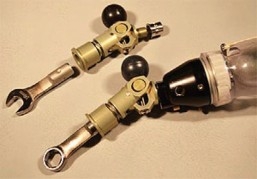
Prosthetic Hand-Tool System
These systems (Figure 17 (The O&P Edge, 2015)) are designed for individuals with upper-limb amputation, partial hand amputation, or hand dysfunction. These systems temporarily replace the hook or prosthetic hand on the prostheses with a terminal device that allows a variety of tools to be inserted. The tools range from dining or cooking utensils; personal grooming devices; and tools for gardening, carpentry, mechanic work, sports, and hobbies.
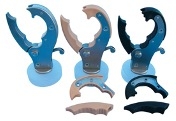
Grip Prehensor
The grip prehensor (Figure 18 (Fillauer, n.d.)) is designed to allow individuals who have had an amputation adjust their grip strength depending on the task they are engaged in.
Conclusion
The assistive technologies included in this publication are just a few examples of assistive technologies that could be useful for farmers who are seeking greater access and better mobility for their upper extremities. This includes the hand, wrist, arm, and fingers. The National AgrAbility Toolbox offers hundreds of examples of assistive technologies for farmers, gardeners, ranchers, and agricultural workers with mobility needs and physical disabilities. Organized by category, this resource contains real-life examples from farmers across the country and showcases products and adaptations that farmers, gardeners, ranchers, and agricultural workers.
Visit the National AgrAbility Toolbox here:
http://www.agrability.org/toolbox/
Additionally, the AgrAbility Virginia website highlights the work of AgrAbility Virginia, with success stories, information about the team, and resources that the team has developed for farmers, ranchers, gardeners, and agricultural workers. Visit the AgrAbility Virginia website here:
https://agrability.alce.vt.edu/
References
AgrAbility. (2016, May 10). One-Handed Garden Tool Handle. National AgrAbility Toolbox. http://www.agrability.org/toolbox/?solution=121
ArthritisSupplies.com. (n.d.). Gripeeze DIY & Garden Glove with Strap Left Hand. ArthritisSupplies.com. https://www.arthritissupplies.com/gripeeze-diy-garden-glove-strap-left.html
ArthritisSupplies.com. (n.d.). Peta Easi-Grip Garden Tools Set of 4. ArthritisSupplies.com. https://www.arthritissupplies.com/peta-easi-grip-garden-tools-set-4.html
Bloomquist, M. (2013, Feb 5). Arthritis-Friendly Tools. Everyday Health. https://www.everydayhealth.com/arthritis-pictures/10-terrific-arthritis-gadgets.aspx
EBK Containers. (n.d.). 3 in 1 Pail Opener. EBK Containers. https://ebkcontainers.com/3-in-1-pail-opener/
Fillauer. (n.d.). Grip Prehensors. TRSProsthetics.com. https://www.trsprosthetics.com/product/adult-grip-prehensors/
Grainger. (n.d.) Irwin Vise-Grip. Grainger. https://www.grainger.com/product/IRWIN-VISE-GRIP-Straight-Jaw-Locking-Pliers-4CHV7
Impacto. (n.d.) Anti-Vibration Air Glove Hi-Visibility. Impacto. https://www.impacto.ca/products/anti-vibration-air-glove-hi-visibility/
MobilityWorks. (n.d.) Steering Wheel Spinner Knobs and Driving Aids. MobilityWorks. https://www.mobilityworks.com/hand-controls/spinner-knobs/
MPS Driving Aids. (n.d.). Quad Fork Spinner. MPS Driving Aids. https://www.mpsdrivingaids.com/quad-fork-spinner
Mutual Screw & Supply. (n.d.). EZ Red MP31 Automatic Self-Adjusting Water-Pump Pliers. Mutual Screw Supply. https://www.mutualscrew.com/product/ez-red-mp31-automatic-selfadjusting-waterpump-pliers-137012.cfm
The O&P Edge. (2015, Jan 28). Texas Assistive Devices (TAD). The O&P Edge. https://opedge.com/Articles/ViewArticle/NEWS_2015-02-01_27
Rehab Store. (n.d.). Grasping Cuff With Wrist Support. Rehab Store.
https://www.rehab-store.com/p-grasping-cuff-with-wrist-support.html
Sportaid. (n.d.). Sure-Grip V-Grip Spinner Knobs. Sportaid. https://www.sportaid.com/sure-grip-v-grip-spinner-knobs.html
Stoller, N. (2020, Mar). Low-Tech Assistive Technology for Farmers Worldwide. National AgrAbility Project. http://www.agrability.org/wp-content/uploads/2020/03/Low-Tech-Assistive-Technology-for-Farmers-Worldwide-VNTW.pdf
Why Strain?. (n.d.). Leverage Booster. Why Strain? https://www.whystrain.com/
*The authors assume no liability in connection with any use of the products discussed and make no warranty (express or implied) in that respect.
References to products are not intended as endorsements to the exclusion of others that might be similar.
AgrAbility Virginia is funded by AgrAbility Project, USDA/NIFA Special Project 2019- 2022 (41590-22326) and administered by Virginia Tech, Virginia State University, Easter Seals UCP North Carolina/Virginia, Inc. and Virginia Cooperative Extension.
Visit us at www.agrabilityvirginia.org.
Virginia Cooperative Extension materials are available for public use, reprint, or citation without further permission, provided the use includes credit to the author and to Virginia Cooperative Extension, Virginia Tech, and Virginia State University.
Virginia Cooperative Extension is a partnership of Virginia Tech, Virginia State University, the U.S. Department of Agriculture, and local governments. Its programs and employment are open to all, regardless of age, color, disability, sex (including pregnancy), gender, gender identity, gender expression, genetic information, ethnicity or national origin, political affiliation, race, religion, sexual orientation, or military status, or any other basis protected by law.
Publication Date
October 14, 2021



